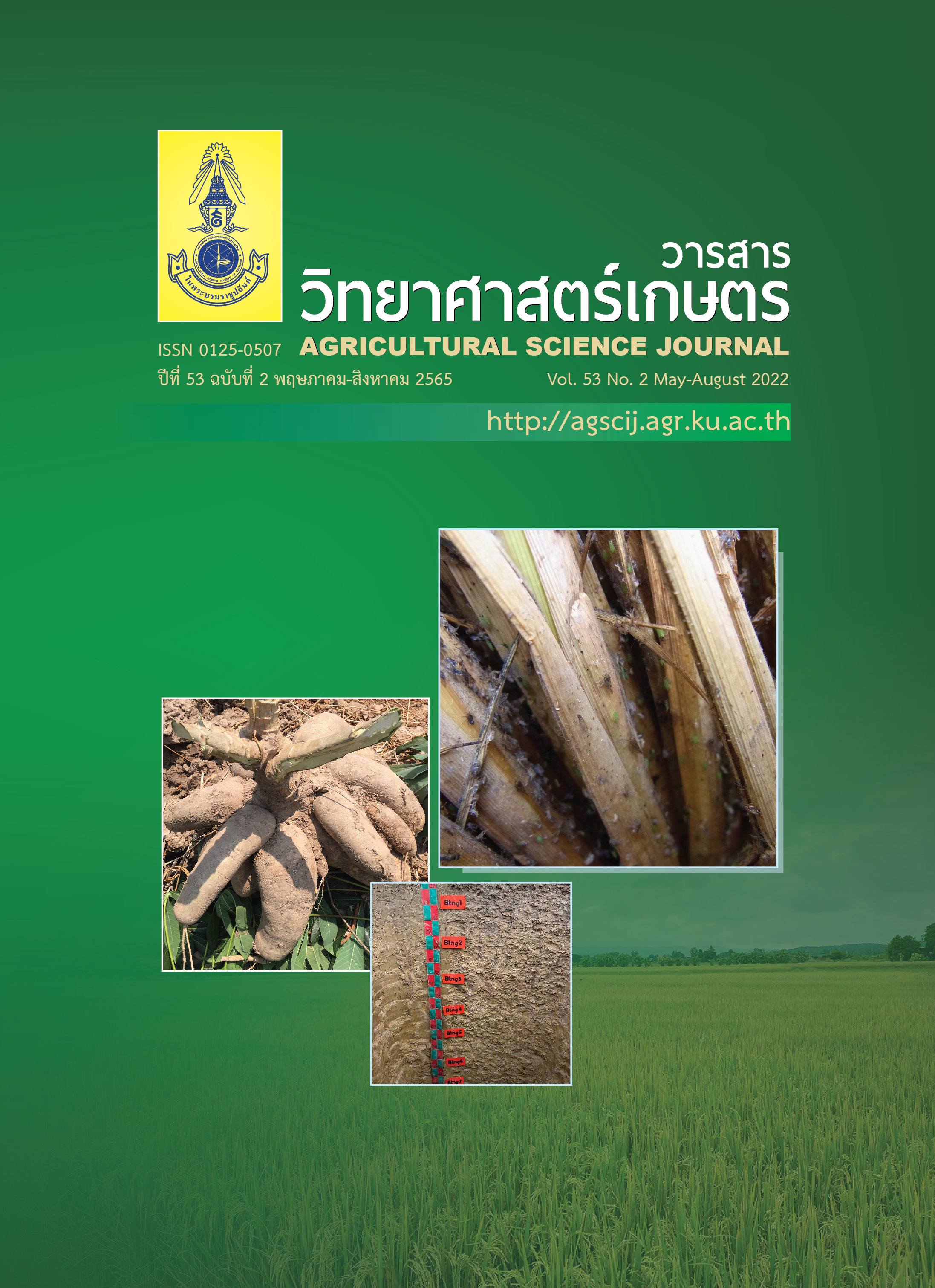การพยากรณ์ปริมาณน้ำหลากเขตพื้นที่ทำเกษตรของชุมชนในเขตรับน้ำจังหวัดพระนครศรีอยุธยา โดยแบบจำลองโครงข่ายประสาทเทียม
Main Article Content
บทคัดย่อ
การศึกษานี้มีวัตถุประสงค์เพื่อพัฒนาแบบจำลองระบบโครงข่ายประสาทเทียมสำหรับการคาดการณ์พยากรณ์ปริมาณน้ำหลากเขตพื้นที่ทำการเกษตรของชุมชนเขตรับน้ำจังหวัดพระนครศรีอยุธยา พื้นที่ศึกษา คือ ชุมชนทับน้ำ-บ้านม้า โดยใช้ข้อมูลระดับน้ำและปริมาณน้ำฝนจากสถานีวัดระดับน้ำลุ่มน้ำเจ้าพระยาตอนล่างและคลองทับน้ำ ข้อมูลที่ได้ถูกนำมาสร้างแบบจำลองโครงข่ายประสาทเทียมแบบการพยากรณ์อนุกรมเวลาคาดการณ์ระดับน้ำ ช่วงเวลารายวัน รายสัปดาห์ และรายเดือน ผลการศึกษา พบว่า การพยากรณ์ระดับน้ำรายวันด้วยแบบจำลองระบบโครงข่ายประสาทเทียมหลายชั้นจากสถานีวัดระดับน้ำลุ่มน้ำเจ้าพระยาตอนล่างมีประสิทธิภาพอยู่ในเกณฑ์ดี โดยค่าสัมประสิทธิ์สหสัมพันธ์ระหว่างข้อมูลที่ตรวจวัดจริงและข้อมูลจากการพยากรณ์อยู่ในเกณฑ์ที่ยอมรับได้ (Correlation coefficient; r = 0.9975 และ 0.6843 สำหรับขั้นตอนการฝึกและการทดสอบ ตามลำดับ) และสามารถเรียนรู้ข้อมูลได้อย่างแม่นยำ ค่ารากที่สองของค่าความคลาดเคลื่อนกำลังสองเฉลี่ยต่ำที่สุด (Root mean square error; RMSE = 0.2783 และ 0.1394 สำหรับขั้นตอนการฝึกและการทดสอบ ตามลำดับ) เมื่อเปรียบเทียบกับผลการพยากรณ์รายสัปดาห์และรายเดือน สำหรับคลองทับน้ำ ผลการพยากรณ์รายวันมีประสิทธิภาพอยู่ในเกณฑ์ดี ค่าสัมประสิทธิ์สหสัมพันธ์ระหว่างข้อมูลที่ตรวจวัดจริงและข้อมูลจากการพยากรณ์อยู่ในเกณฑ์ที่ยอมรับได้ (r = 0.9975 และ 0.6754 สำหรับขั้นตอนการฝึกและการทดสอบ ตามลำดับ) และสามารถเรียนรู้ข้อมูลได้อย่างแม่นยำ โดยมีค่ารากที่สองของค่าความคลาดเคลื่อนกำลังสองเฉลี่ยต่ำที่สุด (RMSE = 0.1841 และ 0.1041 สำหรับขั้นตอนการฝึกและการทดสอบ ตามลำดับ) ส่วนการพยากรณ์ระดับน้ำรายสัปดาห์และรายเดือนให้ผลการพยากรณ์ที่มีความแม่นยําน้อยลงตามระยะเวลาที่ยาวนานขึ้น โดยมีค่าสัมประสิทธิ์สหสัมพันธ์อยู่ระหว่าง 0.6531–0.9508 และค่ารากที่สองของค่าความคลาดเคลื่อนกําลังสองเฉลี่ยระหว่าง 0.4570–0.8639 แสดงให้เห็นว่า แบบจําลองโครงข่ายประสาทเทียมมีความน่าเชื่อถือเหมาะสำหรับนำไปประยุกต์ใช้ในการพยากรณ์ระดับน้ำ เพื่อช่วยในการปฏิบัติงานจริงได้อย่างมีประสิทธิภาพต่อไป
Article Details

อนุญาตภายใต้เงื่อนไข Creative Commons Attribution-NonCommercial-NoDerivatives 4.0 International License.
เอกสารอ้างอิง
Alon, A.S., J.N. Mindoro, C.D. Casuat, M.A.F. Malbog and J.A.B. Susa. 2020. An inference approach of flood level detection and alert system: flood-induced simulated environment. IJATCSE. 9(2): 2259–2264.
Blöschl, G., J. Hall, J. Parajka, R.A.P. Perdigão, B. Merz, B. Arheimer, G.T. Aronica, A. Bilibashi, O. Bonacci, M. Borga, I. Canjevac, A. Castellarin, G.B. Chirico, P. Claps, K. Fiala, N. Frolova, L. Gorbachova, A. Gül, J. Hannaford, S. Harrigan, M. Kireeva, A. Kiss, T.R. Kjeldsen, S. Kohnová, J.J. Koskela, O. Ledvinka, N. Macdonald, M. Mavrova-Guirguinova, L. Mediero, R. Merz, P. Molnar, A. Montanari, C. Murphy, M. Osuch, V. Ovcharuk, I. Radevski, M. Rogger, J.L. Salinas, E. Sauquet, M. Sraj, J. Szolgay, A. Viglione, E. Volpi, D. Wilson, K. Zaimi and N. Zivkovic. 2017. Changing climate shifts timing of European floods. Science. 357(6351): 588–590.
Bomers, A., B. van der Meulen, R.M.J. Schielen and S.J.M.H. Hulscher. 2019. Historic flood reconstruction with the use of an artificial neural network. Water Resour. Res. 55: 9673–9688.
Boontawee, N., N. Saepaisarn, N. Wattanavong, P. Piyakuldumrong, P. Wongrattanakumphon and S. Opasanon. 2021. Improving the performance of windstorm disaster warning dissemination: a case study of Thailand tropical storm Pabuk. Chulalongkorn Business Review. 43(167): 1–21. (in Thai)
Chaipimonplin, T. 2018. Artificial neural network model for water level forecasting at lower Yom catchment with rainfall grid data from climate model. Journal of Social Sciences Srinakharinwirot University. 21: 80–93. (in Thai)
Chaisompran, Y. and T. Chaipimonplin. 2017. Water level forecasting by artificial neural network model with rainfall data from WRF–ECHAM5 model. Srinakharinwirot University (Journal of Science and Technology). 9(17): 83–90. (in Thai)
Daengkanit, A., A. Mankong, O. Prasert and S. Rattanapong. 2017. Mechanisms of rubber situation analysis and urgent information distribution. Journal of Economics Ramkhamhaeng University. 3(2): 1–41. (in Thai)
Department of Disaster Prevention and Mitigation. 2021. Situation report disaster. Available Source: http://portal.disaster.go.th/portal/ext/nirapai/2021093007.pdf, April 12, 2022. (in Thai)
Hollingsworth, A., K. Arpe, M. Tiedtke, M. Capaldo and H. Savijärvi. 1980. The performance of a medium-range forecast model in winter–impact of physical parameterizations. Mon. Weather Rev. 108: 1736–1773.
Hydro Informatics Institute. 2012. Data collection and analysis operations data warehouse system development project for 25 watersheds and flood and drought model. Available Source: https://tiwrm.hii.or.th/web/attachments/25basins/10–chaopraya.pdf, April 12, 2022. (in Thai)
Jetpipattanapong, D. and R. Tanapattanadol. 2010. A comparative impact study of the changing number of outputs in artificial neuron network on Yom River tide forecasting, Phrae province. Journal of Environmental Management. 6(2): 35–53. (in Thai)
Khamkaew, N., N. Kaewthong and P. Ditthakit. 2020. Inflow forecasting of Pa Phayom reservoir using genetic programming. J. Sci. Tech. UBU 22(1): 136–147. (in Thai)
Kongwichianwat, C. 2018. Flood Relief Project in the Lower Chao Phraya River Basin. Available Source: http://www.dsdw2016.dsdw.go.th/doc_pr/ndc_2560-2561/PDF/8365sc/8365.pdf, June 8, 2020. (in Thai)
Kontochimplee, T., K. Pongput and N. Majang. 2018. Forecasting of reservoir inflow using artificial neural networks. In Proc. the 11th THAICID National Symposium, 20 June 2018. (in Thai)
Leknoi, U. 2019. Situation and trend of disasters. Available Source: http://www.cusri.chula.ac.th/wp-content/uploads/2019/09.pdf, April 12, 2022. (in Thai)
Malarvizhi, R. and A.S. Thanamani. 2012. K–nearest neighbor in missing data imputation. IJERD. J. 5(1): 5–7.
Meteorological Department. 2017. Annual Report 2017. Available Source: https://www.tmd.go.th/aboutus/annual_report2560S.pdf, July 24, 2020.
Mongkolngam, K. and K. Choensirichaimongkol. 2015. Application to geographic information system for forecast of flood risk area case study: upper Ping watershed. In Proc. the 8thThai Students Symposium on Geography and Geo-informatics, 25–26 December 2015. (in Thai)
National Strategy Board. 2017. The National Strategy. Available Source: https://www.ldd.go.th/www/files/81731.pdf, June 8, 2020.
Phuphong, S. 2013. Development and Validation of Runoff Forecasting Model for U-Tapao River Basin, Songkhla Province, Thailand. MS Thesis, Prince of Songkla University, Songkla. (in Thai)
Rahim, N.F., M. Othman and R. Sokkalingam. 2018. A comparative review on various method of forecasting crude palm oil prices. J. Phys.: Conf. Ser. 1123: 012043.
Searcy, J.K. and C.H. Hardison. 1960. Double-Mass Curves. United States Government Printing Office, Washington, D.C., USA.
Sola, J. and J. Sevilla. 1997. Importance of input data normalization for the application of neural networks to complex industrial problems. IEEE Trans. Nucl. Sci. 44(3): 1464–1468.
Thumbnum Sub District Administration Organization. 2017. Local Development Plan (2018–2022). Available Source: http://tubnum.go.th/public/plan_upload/backend/plan_99_1.pdf, April 13, 2022. (in Thai)
Tsakiri, K., A. Marsellos and S. Kapetanakis. 2018. Artificial neural network and multiple linear regression for flood prediction in Mohawk River, New York. Water. 10(9): 1158.


